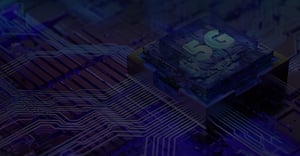5G is delivering unprecedented connectivity for diverse applications – but 5G is relatively-speaking a power hungry technology that doesn't fit all use cases.
Now, 5G RedCap (Reduced Capability) has changed the picture, a version of 5G specifically designed to expand the Internet of Things (IoT). This new standard delivers a middle ground between high-performance 5G devices and low-power IoT solutions.
By offering faster speeds, lower latency, and improved power efficiency compared to older IoT technologies, RedCap balances performance and cost. This opens the door to innovative uses like smart wearables, advanced industrial sensors, and enhanced video surveillance, transforming industries.
What's the history of 5G?
5G, the fifth generation of cellular networks, is the connectivity revolution we're experiencing today. But this technology wasn't born overnight. Its roots go back decades, with the earliest concepts emerging in the 1980s alongside the very first analog cellphones (1G).
The 1990s saw the rise of digital voice (2G), and the early 2000s brought mobile data into the mix (3G). Then, the true mobile broadband era exploded with 4G LTE in the 2010s.
5G builds upon these foundations, promising mind-blowing speeds, incredibly low latency (response times), and the power to connect vast networks of devices. Standardization work began in 2015, with the first commercial launches happening in 2019. Now, 5G's rollout continues worldwide, transforming the way we live, work, and interact with technology.
Understanding 5G RedCap:
5G RedCap is essentially a "lite" version of 5G designed for devices that don't need the full power of the standard 5G network. Think of it as offering the benefits of 5G on a more efficient scale.
It arrived in 2022 and is particularly suited for devices where battery life and size are important, like wearables, industrial sensors, and even some smart home gadgets. While it sacrifices some top speed compared to full 5G, it provides good enough data transfer for these applications and allows them to seamlessly connect within the 5G network. This opens doors for a wider range of devices to join the 5G revolution.
5G has long been important for IoT
The Internet of Things (IoT) relies heavily on seamless connectivity to enable devices to communicate and share data efficiently. 5G plays a pivotal role in transforming IoT by providing several key enhancements:- Faster speeds: 5G offers significantly faster data speeds compared to previous generations, enabling real-time data processing and communication.
- Lower latency: Reduced latency in 5G networks ensures quicker response times, critical for time-sensitive IoT applications like autonomous vehicles and industrial automation.
- Increased device density: The higher device density supported by 5G networks allows for more connected devices per unit area, facilitating the scalability of IoT deployments.
- Improved battery life: Optimizations in 5G technology lead to improved energy efficiency, extending the battery life of IoT devices and reducing maintenance requirements.
Significance Of 5G RedCap For IoT Expansion
5G RedCap takes things a step further for IoT. After all, keep in mind that IoT devices are often tiny – things like sensors, for example that doesn't have access to the power and grunt of a large device.
IoT devices are often also located remotely – far away out of teach of maintenance teams that could easily swap batteries. These are a number of ways in which 5G RedCap will support IoT applications:
- Diverse use cases: The introduction of 5G RedCap expands the horizons of IoT applications by offering tailored solutions for mid-tier use cases that require a balance between performance and cost-effectiveness.
- Enhanced efficiency: By providing higher throughput, longer battery life, reduced complexity, and increased device density compared to LTE technologies, 5G RedCap optimizes connectivity for a wide range of IoT scenarios.
- Future-proofing: The adoption of 5G RedCap ensures that mid-tier IoT designs are equipped to handle future advancements in connectivity requirements, safeguarding investments in IoT infrastructure.
- Cost-effective solutions: The optimized design of 5G RedCap devices contributes to cost-efficient connectivity solutions, making it accessible for a broader range of industries and applications.
- Industry transformation:
In industrial settings, the deployment of 5G RedCap can revolutionize operational efficiencies, support advanced surveillance systems, enhance human-machine interactions, and accelerate the adoption of smart manufacturing practices.
The lightweight nature of 5G RedCap is its key differentiator. Compared to standard 5G, RedCap is simply more suited to lightweight devices – while performing far better, in so many ways, compared to 3G or 4G.
Looking beyond sheer performance
5G RedCap represents a significant leap forward in cellular technology by addressing the specific needs of mid-tier IoT applications.
Its impact on mobile IoT expansion is profound, offering tailored solutions that balance performance optimization and cost-effectiveness, thereby driving innovation across various industries and unlocking new possibilities for connected ecosystems.
Telna is at the forefront of this revolution, offering robust mobile communications for IoT that take full advantage of RedCap's potential. By partnering with Telna, businesses can embrace next-generation connectivity, enabling them to innovate, optimize operations, and gain a competitive edge in the rapidly evolving mobile communications era.
